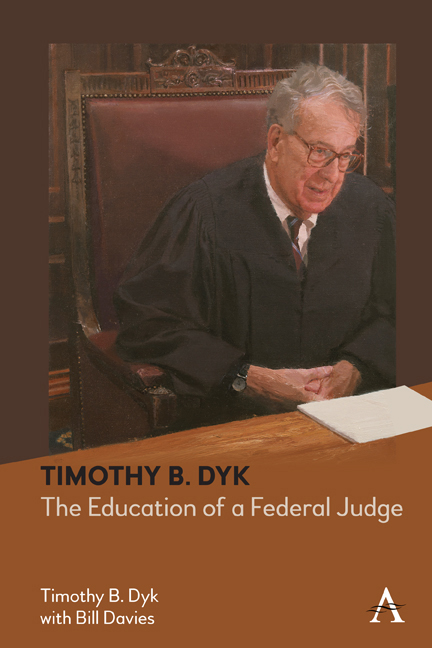Book contents
- Frontmatter
- Dedtication
- Contents
- Foreword
- Acknowledgments
- 1 Introduction
- 2 Family History
- 3 Early Life and Schooling, 1937–61
- 4 Clerking at the Supreme Court, 1961–63
- 5 The Tax Division, 1963–64
- 6 Wilmer Cutler, 1964–90
- 7 Jones Day, 1990–2000
- 8 Reflections on Changes in the Legal Profession
- 9 Becoming a Federal Judge, 1993–2000
- 10 The Confirmation Process, 1998–2000: Selected Diary Entries
- 11 Life as a Federal Judge, 2000–the Present
- 12 Epilogue
- Appendix
- Index
Foreword
Published online by Cambridge University Press: 15 September 2022
- Frontmatter
- Dedtication
- Contents
- Foreword
- Acknowledgments
- 1 Introduction
- 2 Family History
- 3 Early Life and Schooling, 1937–61
- 4 Clerking at the Supreme Court, 1961–63
- 5 The Tax Division, 1963–64
- 6 Wilmer Cutler, 1964–90
- 7 Jones Day, 1990–2000
- 8 Reflections on Changes in the Legal Profession
- 9 Becoming a Federal Judge, 1993–2000
- 10 The Confirmation Process, 1998–2000: Selected Diary Entries
- 11 Life as a Federal Judge, 2000–the Present
- 12 Epilogue
- Appendix
- Index
Summary
Tim Dyk began writing this fascinating book with the simple idea of sharing with his children and grandchildren his experiences as both a top of the game lawyer and a respected federal judge. We should be grateful that he decided to share his memoir with the rest of us. His legacy is impressive, spanning American history from John F. Kennedy's New Frontier to the present day, but the Education of a Federal Judge is much more. In detailing Judge Dyk's own education, it educates the reader about the most interesting and significant aspects of the legal profession.
Judge Dyk's long legal career allows him to authoritatively describe the radical change in the legal profession over the past half century, particularly in what is fondly known as “Big Law.” His experience in litigating critical cases involving the First Amendment and federal and state regulation demonstrates the challenges and rewards of private practice and how federal court litigation can rein in overreach by the executive and legislative branches. His welldocumented excruciating path to confirmation as a federal judge provides a window into the broken judicial selection process. Judge Dyk's 20 years as a federal judge on one of our most significant court of appeals provides a detailed and inspiring description of the day-to-day operation of our federal appellate courts.
As a former law clerk to a federal judge and member of the bar, I found the description of the work of a federal judge and the changes in the legal profession in turn to be reassuring and revealing. As a former state attorney general, I found Judge Dyk's description of his career as a litigator to be a notable contribution to understanding how federal court litigation provides an essential check on the other branches of government. But, most significantly, as a former US senator, I found the description of the confirmation process to be both accurate and deeply concerning. Judge Dyk's remarkable career as a lawyer, litigating some of the most significant issues of our time, was ironically a source of problems for his confirmation, providing a warning of the increased political polarization of the selection process for federal judges.
- Type
- Chapter
- Information
- Timothy B. DykThe Education of a Federal Judge, pp. xi - xivPublisher: Anthem PressPrint publication year: 2022

